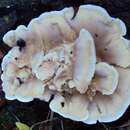Comprehensive Description
(
anglais
)
fourni par North American Flora
Abortiporus distortus (Schw.) Murrill, Bull. Torrey
Club 31: 422. 1904.
Boletus distortus Schw. Schr. Nat. Ges. Leipzig 1 : 97. 1822.
Polyporus aboriivus Peck, Bot. Gaz. 6 : 274. 1881. (Type from Illinois.)
Pileus normally thin, plane or depressed, circular and centrally stipitate when properly
developed, but often aborted and very irregular, varying to entirely resupinate forms, 6-13
cm. in diameter, 0.3-1 cm. thick ; surface conspicuously and compactly tomentose, anoderm,
azonate, smooth, white to alutaceous ; margin thin, undulate to lobed, concolorous : context
soft and spongy above, hard and woody below, white or isabelline, 3-5 mm. thick ; tubes
annual, decurrent, white, 1-5 mm. long, mouths irregular, variable, 2-3 to a mm., edges
thin, entire to dentate: spores subglobose, smooth, h3^aline, 5-7/^ long: stipe central,
unequal, very variable, often obsolete, resembling the pileus in surface and context.
Type locality : North Carolina.
Habitat ; About stumps, roots and other dead wood of deciduous trees.
Distribution ; Canada, and the United States west to Wisconsin and Texas.
- citation bibliographique
- William Alphonso MurrilI, Gertrude Simmons BurIingham, Leigh H Pennington, John Hendly Barnhart. 1907-1916. (AGARICALES); POLYPORACEAE-AGARICACEAE. North American flora. vol 9. New York Botanical Garden, New York, NY
Comprehensive Description
(
anglais
)
fourni par North American Flora
Bjerkandera puberula (Berk. & Curt.) Murrill
Daedalea puberula Berk. & Curt. Grevillea 1 : 67. 1872.
Polyporus fragrans Peck, Ann. Rep. N. Y. State Mus. 30 : 45. 1878. (Type from New York, on
dead elm trunks.) Bjerkandera fragrans Murrill, Bull. Torrey Club 32 : 636. 1906.
Pileus irregular, dimidiate, imbricate, effused-reflexed, 2.5-5X5-10X0.5-1.5 em. ; surface minutely tomentose, somewhat tuberculose, pale red-gray or alutaceous, becoming ochraceous of dull-red after rains ; margin thin, concolorous, at times rugose : context fleshy-tenacious to soft-corky, slightly zoned, subfibrous, concolorous, with a distinct odor of dry seneca-grass ; tubes 2 mm. long, at first whitish, becoming darker with age and black-spotted when bruised, the mouths minute, angular, unequal, 2 to a mm., at length sinuate, dissepiments thin, acute, dentate or lacerate : spores globose or ovoid, smooth, hyaline, 5-6 /^ ; hyphae hyaline, 4-6," ; cystidia none.
Type locality : Pennsylvania.
Habitat : Dead trunks of deciduous trees, especially elm.
Distribution : Ontario to New Jersey, and west to Kansas.
- citation bibliographique
- William Alphonso MurrilI, Gertrude Simmons BurIingham, Leigh H Pennington, John Hendly Barnhart. 1907-1916. (AGARICALES); POLYPORACEAE-AGARICACEAE. North American flora. vol 9. New York Botanical Garden, New York, NY

